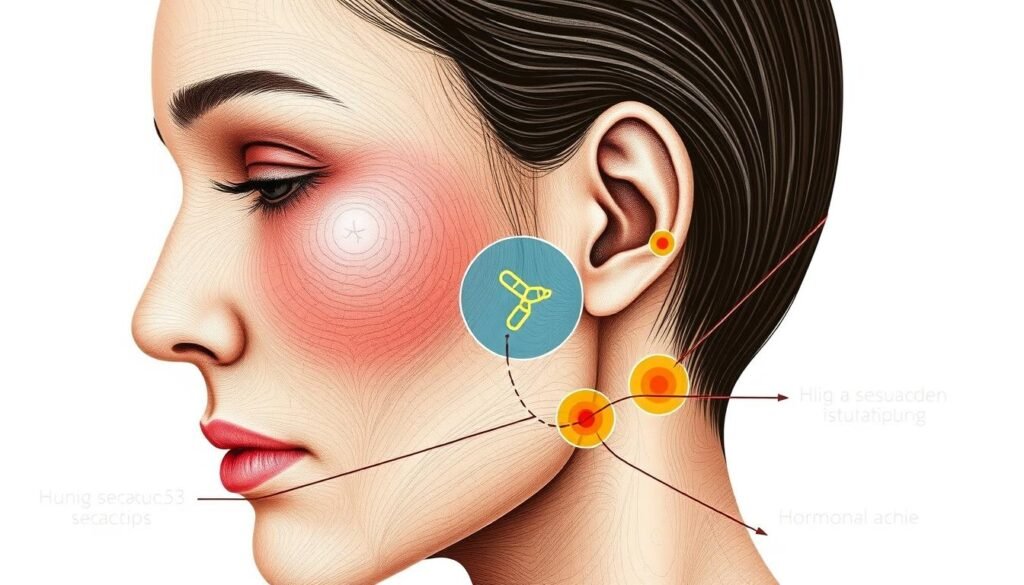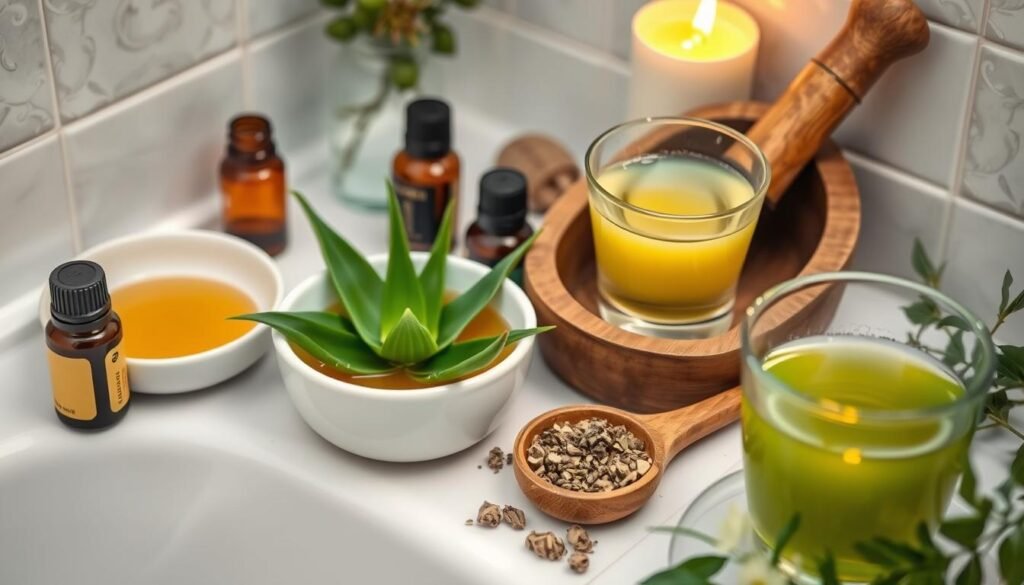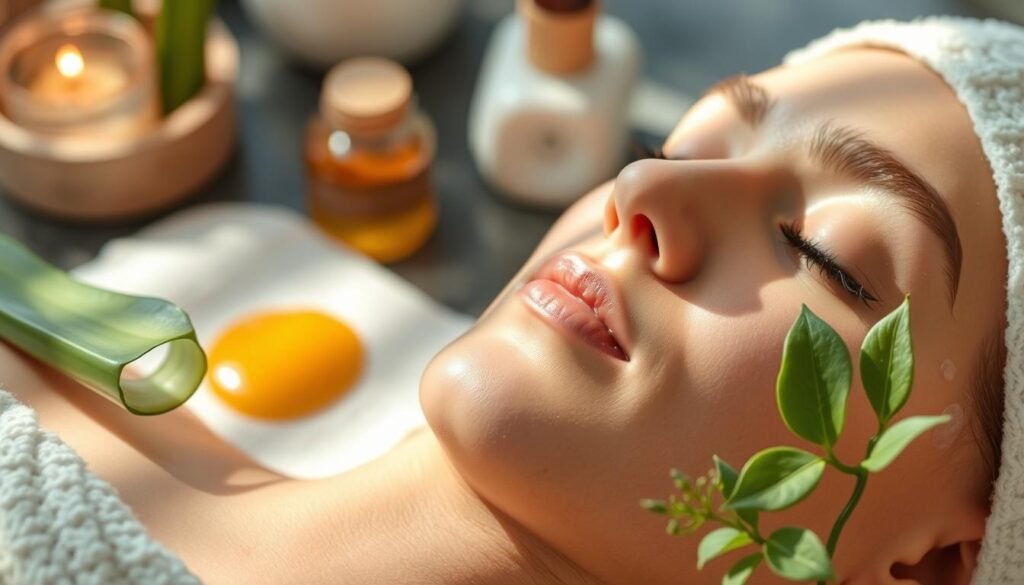Did you know nearly 85% of individuals see a big change in their acne with just one isotretinoin course? However, nodular acne is much harder to treat, often needing more time and specific care.
Nodular acne, or severe acne vulgaris, shows up as deep, painful bumps under the skin. It’s different from milder acne types. Over-the-counter products usually can’t handle this tough skin issue. This guide gives expert advice on beating nodular acne by understanding what it is, why it happens, and how to treat it.
It’s important to treat it right not just to clear the skin but to avoid emotional stress and scars. To learn more about nodular versus cystic acne, check out this link.
Key Takeaways
- Nodular acne is a severe form of acne that needs expert and personal treatment plans.
- Medicines like isotretinoin and antibiotics play a big role in treating nodular acne.
- Good skincare habits can make nodular acne less severe and less frequent.
- Sometimes, you might need professional treatments like chemical peels or laser therapy for the best results.
- Knowing what causes nodular acne is key to managing and treating it well.
- Seeing a dermatologist is important for getting a treatment plan that works for your nodular acne.
Understanding Nodular Acne
Nodular acne is a tough type of inflammatory acne, unlike common pimples. It features solid, painful bumps deep under the skin. These nodules can last weeks or months. They often lead to significant discomfort and scarring risk.
What is Nodular Acne?
Nodular acne forms large, painful nodules. These nodules don’t come to a head like in cystic acne, which has fluid-filled cysts. Over-the-counter treatments usually don’t help much. Effective treatment might include retinoids, antibiotics, or isotretinoin. Hormones, especially during puberty, menstruation, or pregnancy, can trigger it.
How Nodular Acne Differs from Other Types of Acne
Nodular acne is different, especially from cystic acne. It has hard, painful nodules. In contrast, cystic acne has large, inflamed cysts. Both can lead to scarring without treatment. Nodular acne often needs professional help, like corticosteroid injections.
Keeping the skin clean and not touching the nodules can help. This reduces scarring and manages the condition better. For more on treatments, see articles here and alternative approaches here.
Causes of Nodular Acne
Nodular acne involves several key factors. Understanding them can help find the right treatments. Hormones, genes, and diet play big roles. Each has a major effect on how nodular acne starts and stays.
Hormonal Factors
In women, hormones can trigger nodular acne. Changes during menstrual cycles increase oil and clog pores. This environment is perfect for nodular acne. Androgens, hormones in both men and women, ramp up oil production. This makes things worse over time.
Genetic Predisposition
Genes affect your chances of getting nodular acne. If your family has it, you might too. Studies show nodular acne can run in families. It highlights how crucial genetics are. Those with a family history should be extra careful.
Dietary Influences
Diet also plays a role in nodular acne. Dairy and high-sugar foods might worsen it. The link between diet and skin health is getting stronger. For many, adjusting diet is key to managing acne.

| Factor | Impact on Nodular Acne |
|---|---|
| Hormonal Influences | Increased oil production leading to clogged pores |
| Genetic Predisposition | Higher risk if family members have similar issues |
| Dietary Influences | Triggers seen with dairy and high glycemic foods |
Symptoms of Nodular Acne
Nodular acne has unique signs. It’s crucial to spot these early. Knowing the Acne Nodules Appearance helps people get treatment in time. This avoids more health issues.
Physical Appearance of Nodules
Nodular acne shows up as hard, sore lumps under the skin. They’re often pink or red. These lumps have different sizes and can cause swelling nearby.
The Symptoms of Nodular Acne also bring papules, pustules, and cysts. The nodules are bigger and stick around longer. If not treated well, the condition can get worse, leading to painful, smelly lumps.
Pain and Sensitivity
The worst part of nodular acne is the Painful Acne Symptoms. Touching the lumps makes the pain worse. This happens because the nodules are inflamed. If the problem keeps up, the pain gets stronger. This shows why it’s key to find good treatments for these breakouts.
Nodules Acne Treatment Options
Nodular acne needs strong treatment strategies starting with prescription creams. These treatments are made to fight the root causes of severe acne. By using both creams and pills, people can relieve painful nodules and control their acne.
Topical Prescription Medications
Stronger creams are key in treating nodular acne. Formulas with benzoyl peroxide, adapalene, and tretinoin work well. They open up pores and lessen redness. Azelaic acid is also effective and should be used twice a day.
Studies show these creams start working in four to eight weeks. The American Academy of Dermatology says they’re safe for most, including young users.
Oral Medications and their Benefits
For tough cases, oral antibiotics like doxycycline or minocycline are options. They target bacteria and swelling. Isotretinoin, for the worst cases, takes time but helps a lot. Hormonal contraceptives, approved by the FDA, balance hormones to lessen breakouts.
Steroid shots can quickly ease nodular and cystic acne lesions. They bring fast relief and less pain. People with nodular acne should get personalized plans from experts. For more on treatments, visit this resource.
Over-the-Counter Products for Nodular Acne
Many people use OTC acne treatments to help with nodular acne. These products can offer relief, but it’s important to know their pros and cons. This knowledge helps effectively manage the condition.
Ingredients to Look For
Choosing the right ingredients for acne is crucial. Important ones to consider are:
- Benzoyl Peroxide: This fights acne-causing bacteria and eases inflammation. It comes in strengths from 2.5% to 10%.
- Salicylic Acid: It exfoliates the skin and opens clogged pores. This prevents new acne from forming.
- Hydrocortisone: Creams with hydrocortisone lessen redness and swelling in cystic pimples. They offer quick relief for irritated skin.
- Sulfur: Good at reducing oil and acne bumps. It’s great for oily skin types.
Limitations of OTC Products
OTC acne treatments have their downsides. They usually work on the skin’s surface. They might not go deep enough to fix the deep issues causing nodular acne. While they can lessen surface symptoms, they often don’t get to the root of severe acne.
At-Home Remedies for Nodular Acne
Trying to handle nodular acne from home can really help your skin. A Skincare Routine for Nodular Acne should focus on softly cleaning, keeping skin moist, and choosing the right products. It’s very important to know what’s in your skincare items to reduce redness and help your skin heal faster.
Skincare Routine Tips
Keeping up with your skincare routine can make a big difference. Here are some key tips:
- Wash your face in the morning and night with a soft cleanser to get rid of grime and oil.
- Opt for products with benzoyl peroxide or salicylic acid to fight off acne bugs.
- Moisturize well with light creams or lotions to keep pores clear.
- Avoid touching your face too much to keep bacteria and inflammation down.
- Try stress-relieving activities like meditation, because stress can make acne worse.
DIY Masks and Treatments
There are also DIY Treatments for Acne to try, like clay masks that pull out dirt. These homemade options can soothe your skin in gentle ways:
- Green clay masks grab excess oil and yucky stuff out of your skin.
- A study in 2021 showed aloe vera gel might calm acne and lessen dark spots when used with ultrasound.
- Oatmeal masks are great for soothing and reducing the red and swollen parts of nodular acne.
While trying At-Home Acne Remedies, knowing when to see a doctor is key. If your acne is very bad and doesn’t get better with home care, a dermatologist can help. They can stop scarring and get your breakouts under control.

Professional Treatment Procedures
Professional treatments are great for those dealing with nodular acne. There are many methods, each designed for specific issues. With these treatments, people can see their skin get much better.
Chemical Peels
Chemical peels deeply exfoliate the skin, helping with texture and lessening acne marks. They involve putting a chemical solution on the skin. This takes off the top skin layers, revealing new, healthy skin. Chemical peels clear out nodules, heal skin quicker, and stop new breakouts by cleaning pores.
Laser Therapy
Laser therapy tackles both the inflammation and bacteria of acne. Lasers deliver focused energy deep into the skin. This kills bacteria, lowers cystic acne, and aids in healing. It’s a safe option that avoids scarring, providing lasting results without surgery.
Corticosteroid Injections
Corticosteroid injections quickly ease pain and swelling in severe acne nodules. They are injected right into the acne, bringing down swelling fast and helping healing. This treatment is perfect for those with sudden acne flares, giving fast relief and faster healing.
| Treatment Method | Primary Benefits | Targeted Issues |
|---|---|---|
| Chemical Peels | Deep exfoliation, improved skin texture | Existing nodules, clogged pores |
| Laser Therapy | Targeted bacteria elimination, reduced inflammation | Cystic lesions, acne scarring potential |
| Corticosteroid Injections | Fast swelling reduction, pain relief | Large, inflamed nodules |
Preventing Scarring from Nodular Acne
Nodular acne is tough, especially with scarring. Not treating it can badly damage your skin. It’s key to treat it early to avoid scars. By tackling the inflammation quickly, we can dodge dark spots and keep skin healthy.
Importance of Early Treatment
Getting ahead of nodular acne fast is key to stop scars. Treatments like retinoids and hormonal therapies really help. Studies show acting fast can change your skin’s future. Those who start treatment early tend to see less severe symptoms and fewer scars.
Post-Acne Skincare
After acne, the right skincare is crucial for avoiding scars. Products with salicylic acid clean pores and lower inflammation. There’s also hydroquinone, which helps with acne marks, making skin tone even. Proper guidelines improve skin health after acne.

| Skincare Product | Key Benefit |
|---|---|
| Retinoids | Reduces scarring and prevents new acne formations. |
| Salicylic Acid | Unclogs pores and minimizes inflammation. |
| Hydroquinone | Addresses post-acne marks and promotes even skin tone. |
| Apple Cider Vinegar | Offers antibacterial and antimicrobial properties. |
In conclusion, preventing acne scarring with early treatment makes a big difference for nodular acne sufferers. Keeping up with post-acne skincare helps manage the aftermath of breakouts smoothly.
Nodules Acne Treatment: Importance of Consulting a Dermatologist
If you’re battling nodular acne, seeing a dermatologist is key. These experts are trained to handle skin problems well. Through careful checks, they figure out how bad the acne is. This helps them create personal plans for fighting acne, based on what you need.
Assessment of Severity
Dermatologists start by judging how severe your acne is. They put acne into groups from mild to very bad. It’s crucial to know if nodular acne is grade 3 or 4. These levels mean you definitely need expert help, as serious nodular acne can hurt a lot and leave scars. Dermatologists use different ways to see how bad acne is. This ensures the treatment fits your skin’s condition.
Tailored Treatment Plans
After understanding the acne’s severity, dermatologists make custom treatment plans. These may include creams, pills, or advanced options like peels and lasers. They pick therapies that work well together. This helps a lot in fighting nodular acne and getting better skin health.
| Assessment Criteria | Grade 1 | Grade 2 | Grade 3 | Grade 4 |
|---|---|---|---|---|
| Severity Level | Mild | Moderate | Moderately Severe | Severe |
| Typical Lesions | Comedones | Papules/Pustules | Nodules | Cysts |
| Recommended Treatment | Topical OTC | Topical Prescription | dermal injections/medications | Advanced therapies |
Adopting Healthy Skin Care Habits
Taking good care of your skin is key, especially if you have nodular acne. Using the right skin care, like effective cleaning methods, can really improve your skin. It can make it healthier and reduce acne outbreaks.
Cleansing Techniques
Cleansing is the core of skin care. Gentle cleansers, such as CeraVe’s Acne Foaming Cream Cleanser, treat skin well without making it too dry. It has 4% benzoyl peroxide to fight acne but keeps your skin hydrated. Cleansing regularly gets rid of dirt and oil, which helps prevent clogged pores and lowers the chance of acne in the future.
Moisturizing and Sun Protection
Moisturizing is crucial for healthy skin. CeraVe’s PM Facial Moisturizing Lotion gives your skin the moisture it needs at night. It has hyaluronic acid and niacinamide, boosting your skin’s defense. During the day, CeraVe AM Facial Moisturizing Lotion with Sunscreen is best. It hydrates and protects against the sun with SPF 30. This is very important for acne-prone skin to avoid UV damage.
Conclusion
Understanding nodular acne fully is key. This means knowing what causes it and how to treat it well. A good treatment plan often includes medicines like tretinoin and doxycycline. These fight the deep-seated problems causing the acne.
For tougher cases, stronger treatments like corticosteroid shots and isotretinoin might be needed. They help a lot in reducing swelling and keeping scars away. It’s crucial to get medical advice early. Waiting too long can lead to scars that never go away.
A good skincare routine also plays a big role. It’s important to stay patient while treating your acne. By following the right steps and getting advice from professionals, you can see big improvements. Fighting nodular acne can be tough, but with effort, clearer skin is possible.